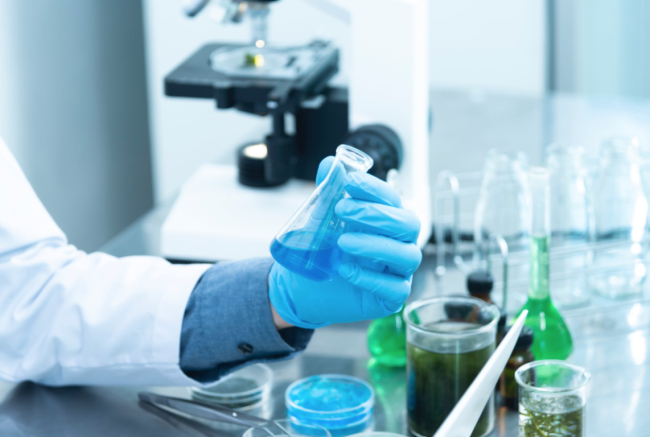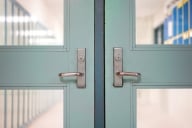You have /5 articles left.
Sign up for a free account or log in.

Pexels.com
Like dominoes being reset after a chain reaction, nonessential research labs are opening back up -- typically in the reverse order they were shut down due to COVID-19.
It is not back to business as usual. Some labs can’t reopen yet at all, as they deal in human subjects research or are hard to access due to remaining travel restrictions. And those labs that are open now are mostly staffed in shifts, with personnel wearing masks for hours at a time and staying socially distant from their colleagues. The conditions pose obvious challenges for lab personnel.
Even so, reopening labs amounts to a soft reopening of campuses as a whole. This means that research labs are also test labs for fall.
“We kept 77 labs open [during the pandemic]. We’re now reopening 300 labs, and 12,000 students are arriving in the fall, so the scale keeps growing,” Kirk Dombrowski, vice president for research at the University of Vermont, said recently. These openings, he added, are “all kind of building on each other.”
The labs that never closed at Vermont -- either because they were doing COVID-19-related research or were in the middle of clinical trials or other work that couldn’t be paused -- offered some clues about how to reopen nonessential research labs. After learning more about how the coronavirus is transmitted, for example, the university and its essential labs realized that they didn't need to limit occupancy to one scientist to a room, but rather based on total lab square footage. Masks are a must.
Now Dombrowski is signing off on individual, nonessential labs’ safety plans for reopening. Relatively low-risk outdoor work, such as forestry research, resumed quickly. Indoor work required a bit more finesse. Overnight travel for research is restricted, and daily travel happens on a one-scientist-per-vehicle basis.
Things are progressing relatively smoothly, for now. Faculty members and trainees are generally returning to labs and jobs they’re familiar with, in shifts. They know what to do and can work alone, if necessary. Come fall, however, things will be trickier, Dombrowski said.
“The challenge will be rethinking training” for new students and personnel who must in some cases be taught to use complicated equipment or handle lethal chemicals by a socially distant mentor, he said. “Showing someone new how to do some of these things can be very difficult.”
Throughout the pandemic, Dombrowski said, he’s shared concerns with and learned from other research administrators via the Association of Public and Land-grant Universities’ Council on Research. The group will continue to be a resource going forward, he said.
Bethany Johns, assistant director of research policy at the association, said the group went into “hyperdrive” in March, focusing on how to ramp down research labs. Once nonessential labs had successfully closed down, she said, the council turned its attention to understanding how social distancing mitigates the spread of the virus, and then how social distancing could be accommodated in the lab environment.
Almost as quickly, she said, “our conversations turned to reopening [labs] … It became clear that this was really going to be the frontier of how to reopen the campuses.”
Still, the pioneering process is a cautious one that is likely to last all summer.
Deborah Altenburg, assistant vice president for research advocacy and policy at the association, said the “snapshot” on lab reopening remains “very, very mixed across the country, depending on the rates of infection in the areas where the schools are.” Some individual labs are opening on a phase-by-phase basis, she said, and need significant time to relaunch their work.
“We don’t know of a campus that is 100 percent back, with all labs open. We are not at that stage yet at all.”
Jen Heemstra, an associate professor of chemistry at Emory University, phased her lab back in this month. There were some awkward moments that betrayed just how long the research group had been away. A mass spectrometer appeared to be broken, when it really just needed to be unplugged and plugged back in. A carbon dioxide hose also came loose midexperiment and killed a bunch of cells.
Over all, though, she said, “Everyone is really happy to be back doing research again.”
Heemstra prepped her students for the transition, including via a column on getting back into the swing of things, published in C&EN. Manage your expectations, as well as your advisers’, she wrote, as “the working conditions that we are under right now could remain in place until there is a vaccine for COVID-19, and that could be a while.”
In an interview, Heemstra also attributed the relative smoothness of her own lab’s transition to Emory’s process.
“Our university did a really great job with the this,” establishing basic safety guidelines that it sent down to individual schools, departments and, finally, labs, she said. “We were given quite a bit of latitude to customize the plan to the type of lab space we had and the work we do.”
Heemstra wrote her lab’s safety plan in consultation with her graduate students, who had helpful suggestions. They designated someone in each shift, morning and afternoon, as a safety liaison for any questions or concerns about protocol, for example. They thought about how to safely arrange the sharing of equipment with other labs, and put a whiteboard outside a small, enclosed area of the lab, to mark when it's occupied.
There are minor inconveniences, such as the elimination of shared space to eat or prepare food or -- gasp -- get coffee. The biggest one is outside the lab, in Emory’s integrated core facilities area. Previously, graduate students and postdoctoral fellows used the expensive, advanced technologies housed there by themselves. But departments have decided that they will drop off samples instead, for core facilities personnel to run. Those personnel are experts in the equipment, Heemstra said, but they are not expert in the particulars of every experiment, such as, say, getting the perfectly placed screen grab of a sample via electron microscopy.
“This is one of the bigger challenges we are going to face,” Heemstra said.
Perhaps until fall, that is, when new recruits start to arrive. Luckily, Heemstra said, she has a relatively large lab, which was able to reopen with "conservative" social distancing parameters that can be adjusted if necessary: one person per 250 square feet of space, with six feet of space between them at all times. These distances are blocked out across the lab, especially around shared equipment.
While Heemstra's crew is back in the lab, questions remain across academe about who will be required to return to lab work -- and campus in general -- come fall. Heemstra said she made the return optional for all her students, but that they all agreed to return. In many cases, she said, they embraced a return to some sense of normalcy and routine, and the opportunity to engage with lab mates who are their friends. Most are able to bike to campus or drive, she said, eliminating concerns about having to use public transport to get there.
Still, some students in other labs will not want to return to the lab for various reasons, and the initial federal guidance saying that they may continue to be paid for remote work that differs from the job descriptions on their federal grants technically expired last week.
The same pressures apply to labs that can’t open up yet, for various reasons. At Vermont, for instance, Breck Bowden, Patrick Chair of Watershed Science and Planning, said earlier this month that he risked losing a year’s worth of research at a long-term ecological field site on Alaska’s north slope, based on the state’s travel restrictions to protect local communities.
Bowden, of course, understands those goals. But they mean navigating lots of uncertainty, as “we staff graduate students and postdocs and need to continue to pay them. We can’t just stop, and yet they can’t accomplish many of the objectives that they thought they’d be working on during this time period.”









